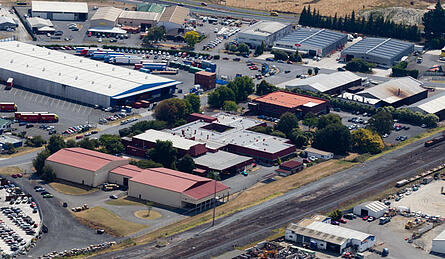
Good growth: Hamilton’s industrial precincts grew while vacancy rates fell across the city last year.
Around 3000 square metres of industrial land was bought or leased in Hamilton last year, a sign of strong growth in the city, commercial property experts say.
About 37,200 sq m of space was added to Hamilton's industrial stock last year, an annual survey of industrial land compiled by NAI Harcourts and CBRE has shown.
In that time, overall vacancy levels dropped from 5.7 per cent in 2011 to 3.6 per cent, as about 3000 sq m of space was leased or bought.
"The city has a filling-up feel about it which is really good," NAI Harcourts director Theo de Leeuw said.
"The filling-up is both owner-occupiers who are buying and taking advantage of the lower interest rate regime as well as tenancies expanding."
De Leeuw said part of the growth was due to a squeeze on industrial space in Manukau and South Auckland which has seen a shift of focus for industrial companies now seeing Hamilton as a viable alternative.
"Hamilton is really becoming the next destination to do warehousing, manufacturing . . . and it has great proximity to other markets like Auckland," he said. "We are getting enquiries from businesses outside the city who are looking for locations inside the city . . . a number of people are looking at Hamilton and the Waikato positively as a food bowl and being able to service that."
Trends noted by the survey included a drift of industrial companies from Frankton to Te Rapa, but Frankton vacancies still fell by 1.3 per cent last year.
De Leeuw said new start businesses were taking advantage of Frankton's established industrial strength and close proximity to the CBD.
Karl van Gisbergen, also a director at NAI Harcourts, said the number of large industrial leases signed on to between $100,000 and $250,000-a-year last year increased significantly.
"The activity is there at present and from the mood out there it certainly seems sustainable, we haven't seen that since 2007 or 2008," he said.
"It shows you that there are large companies looking to come to Hamilton, or to expand and reactivate development plans.
"Companies that have been sitting on their hands have finally decided that they are going to do something, they're feeling the uplift."
Monitored industrial building stock in Hamilton now measures 1.5 million sq m - about an eighth of the size of Auckland's industrial market.
The industrial precinct known as Te Rapa North experienced the most industrial development last year, a total of 16,503 sq m, with the completion of large-scale projects such as the 2912 sq m Couplands Bakery building.
Stock volumes in Te Rapa South grew by 14,986 sq m over the year with new builds such as the 4124 sq m Perry Metal Protection factory.
Frankton saw a minor increase of 3106 sq m, but most of that was the addition of several industrial properties to the survey which are outside the Hamilton city boundary. All industrial precincts recorded an overall decrease in vacancy over the past year, with the largest improvement in Te Rapa South and North where vacancies more than halved.
Frankton has the highest overall vacancy rate at 5.8 per cent, down from 7.1 per cent.
The Te Rapa North precinct has the lowest overall vacancy rate at 1.3 per cent, down from 3.4 per cent, and the Te Rapa South vacancy rate fell 3 per cent from 5.4 per cent to 2.4 per cent. The survey identified 52 industrial-zoned sites that were vacant, which measured a total of 28.4 hectares, on the market and available for development, most of which are 0.5ha or less.
Frankton has 12.8ha of that vacant land, Te Rapa North has slightly less with 10.7ha and Te Rapa South has only 2.9ha free.
Six sites are available over 4ha, all within the Frankton precinct, and the largest space available is a 6.1ha block at 17-43 Gallagher
Waikato Times 13/03/2013
Journalist: KASHKA TUNSTALL;